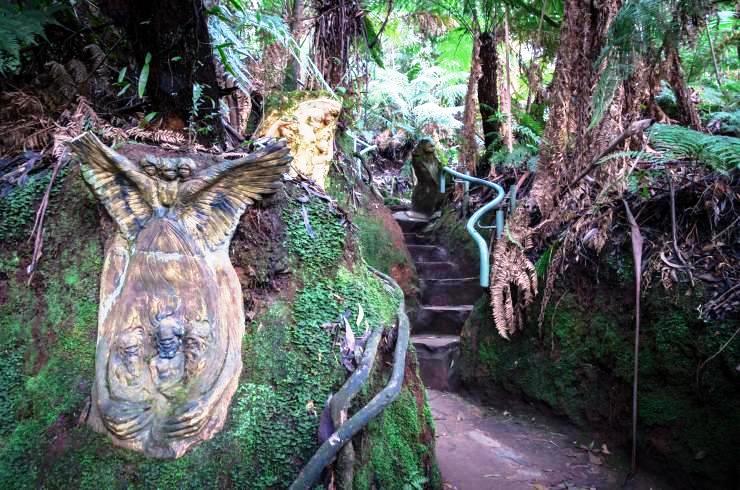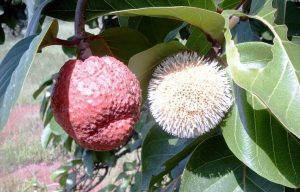Modelled in clay, placed between rocks and tree trunks, 92 Aboriginal sculptures in Melbourne, Australia, reflect the ecological idea of the intrinsic connection between humans and fauna and flora that form a single living being.
The Dandenong Ranges and Yarra Valley, less than 40 kilometres from Melbourne, the capital and most populous city of the state of Victoria in south-eastern Australia, are a verdant region of rainforests and human farms that attracts artists and lovers of nature.
In this earthly paradise is the William Ricketts Sanctuary, a collection of 92 clay sculptures created by the sculptor from whom the space takes its name. The self-taught artist, born in 1898 in Richmond, Victoria, Australia, rejected city life, preferred to immerse himself in nature and created sculptures in honour of the Aboriginal people and the fauna and flora native to Australia.
The sanctuary is a place of beauty, tranquillity and mysticism. William Ricketts, who lived there until his death in 1993, believed that nature was entrusted to man. He was a naturalist concerned about the mass destruction of the environment and its ecosystems. In his life philosophy, deepened by his closeness to Aboriginal culture, the Earth is a single living being in which everything fits together; if we feed it, we live, but if we mistreat it, we all die.
For this reason, his clay sculptures are in harmony with the native trees and those he planted, even among the rocks, including their colours, and form a whole with the rustic paths that lead to every corner of the park. Many pieces throughout the sanctuary contain aquatic elements, representing the fluid essence of life. The wood and stone benches placed throughout the park offer a place for reflection.
William Ricketts began modelling clay as a recreational and relaxation activity. But the desire to create ceramic art comes from a deep love for the Earth and, in particular, for his native Australia and, in particular, for living beings, humans, plants and animals. At the age of 36, he started by purchasing an acre and a half of land in the Dandenong Ranges. He built his house there. He brought with him his mother and a pet white rabbit.
In his luggage there were also his violin and tools for working with clay. Ricketts wanted his garden to be full of pure Australian flora. Birds sang among the tall eucalyptus trees. The mountain ferns and ash trees were his paradise. Then, in his rudimentary oven, he baked clay sculptures with figures and elements from Aboriginal mythology. For outdoor sculptures he used enamels, so that moss and lichens grew on them.
He placed them among rocks and plants, merging them with nature as an expression of Aboriginal spirituality: all men must act as guardians of the natural environment. As William Ricketts increased the number of his sculptures, his name and legacy became increasingly controversial. On the one hand, because he claimed to love Australia for its ancient Aboriginal history and not for its more recent colonial past, which offended certain sensitivities, especially in the cities and among Australians who had emigrated to Western countries.
Secondly, he argued that humanity should collaborate with nature, not against it, in a society where progress was made – as in many other parts of the world – at the expense of the environment, a fact that for most people in society, it was not considered as problematic as it is today. “They are bastards! They cut down trees and kill animals. Today people in the world can destroy everything there is,” Ricketts told the Canberra Times in 1988.
Several sculptures by William Ricketts are called “Earthly Mother”. They all depict Aboriginal women with their children and symbolize the unity between humanity and nature. The work “Australia Crucified” expresses Ricketts’ anguish at the clearing of the region’s forests. Before he was born, Mountain Ash was cleared to build the city of Melbourne. During his lifetime, the government approved other clearings to give up the areas to herders and settlers and to logging. The Australian artist was particularly disconcerted by the loss of habitat for animal species.
In “Everlasting Home Pmara Kutata”, William explores Aboriginal ancestry. The sculpture suggests a state of sleep and dream. Supernatural beings create the landscape, its creatures and the Aboriginal people, which Aboriginal mythology translates as sacred land or eternal home, and the people, over time, tire and fall asleep.
The “Tree of Life” sculpture is where William Ricketts’ ashes are buried, according to his will. This symbolic sculpture shows the artist’s belief in returning to the earth after death and his commitment to unity with the Sanctuary. A curiosity: the ash tree in which the work was inserted was a small tree when the artist arrived at the Sanctuary. Today it is very big indeed. (M.M) – (Photo: 123rf)







